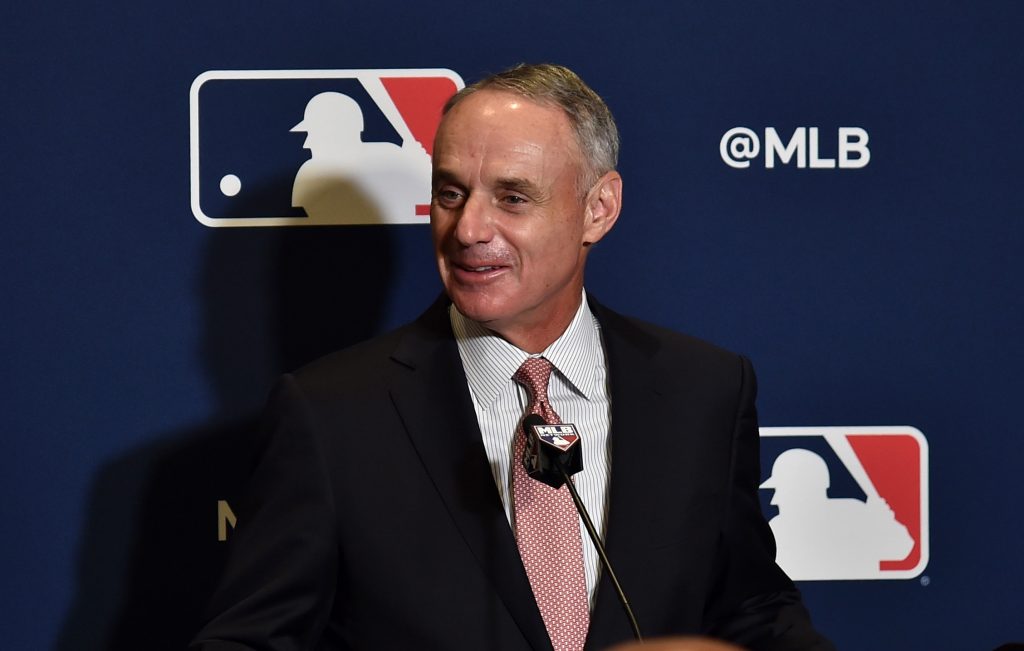
Under the terms of the 2016-21 collective bargaining agreement, Major League Baseball had the authority to unilaterally implement on-field rules changes one year after formally proposing them to the Players Association. Even in the event the MLBPA rejected the specific idea under consideration, the league could put that provision into place one season later.
As part of this week’s negotiations on a new CBA, MLB has pursued a shorter ramp-up period for its ability to implement rules changes, report Evan Drellich and Ken Rosenthal of the Athletic. The exact grace period the league was targeting remains unclear, but MLB evidently doesn’t want to have to wait an entire year to implement rules adjustments without the union’s approval. The league would need the MLBPA’s approval to include the broad authority to expedite rules alterations in the next CBA, though, and Drellich and Rosenthal hear the union responded negatively to the league’s initiative.
While the league could leverage a shorter grace period to more quickly pass any number of rules changes, it seems the current motivation for trying to speed up the process is to more quickly implement one provision in particular: the pitch clock. The Athletic writes that the league specifically cited a pitch clock as a possible alteration it’d be interested in making.
MLB commissioner Rob Manfred voiced support for a pitch clock in November, saying it was a feature “owners remain very interested in” implementing. The league has been testing pitch clocks in the minor leagues as part of its initiatives to quicken pace of play and shorten game lengths, and it’s clear MLB has a desire to carry that over to the big league level.
The precise impact a pitch clock would have is a matter of some debate. Jayson Stark of the Athletic examined the possible impact of the Low-A West’s implementation of a 15-second pitch clock midseason last year, finding that average game length dropped 21 minutes after the clock was put in effect. However, J.J. Cooper of Baseball America pointed out that the implementation of 20-second pitch clocks in Double-A and Triple-A in 2015 had mixed results. Those levels saw an immediate significant drop in average game time, but game length gradually rose over time and eventually exceeded pre-pitch clock levels. There are myriad explanations for why games continue to take longer — more time between pitches, fewer balls in play leading to deeper counts — but the trend in the high minors indicates that merely instituting a pitch clock may not be a panacea in the league’s efforts to shorten games over the long haul.
Fans’ opinions on the pitch clock figure to vary. Some will embrace any opportunity to cut dead time out of the game, while others will recoil at the notion of timing a sport that has traditionally proceeded without clocks. Regardless, it seems MLB is intent on implementing a clock at some point. The players’ opposition to shortening the period for rules changes may be rooted in a broader unwillingness to centralize more power in the league office than in opposition to the pitch clock specifically. Either way, it seems they’re none too keen on the idea of allowing the commissioner to more rapidly change the game’s rules.
The league has used its authority to implement rules changes without union approval in the past. Most notably, MLB implemented the three-batter minimum rule for pitchers (another pace of play initiative) over the 2019-20 offseason. The MLBPA never formally agreed to that change, although they did assent not to challenge MLB’s installation of it as part of a broader package of alterations mutually implemented heading into the 2019 season.
Whether the league and union will discuss any other rules adjustments in the coming days and weeks remains to be seen. Upon announcing MLB’s implementation of the lockout in early December, Manfred indicated on-field rules changes might be tabled while the league and union dealt with core economics problems. Many of those economics issues remain, and time is dwindling for the sides to agree to a new CBA if the league is to start the regular season on time. Limits on defensive shifting and the automated strike zone are among other topics of possible discussion whenever MLB and the union circle back to considering changes to the on-field product.
Credit : Source link






